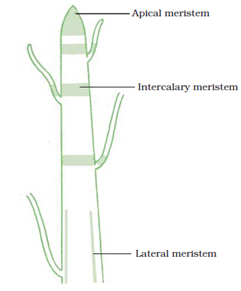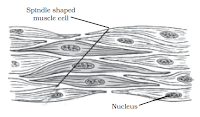CBSE CLASS 9 CHAPTER 6 NOTES
CHAPTER
6
CBSE SCIENCE
CLASS 9
TISSUES
TISSUES
·
Cell – structural & functional unit of life
·
Tissue – group of cells – similar in structure &/or
work together – to achieve a particular function
·
Examples: Muscle, phloem, blood, etc.,
DIFFERENCE BETWEEN PLANT & ANIMAL TISSUE
PLANT TISSUE
·
Plant tissues – based on dividing capacity –
classified into 2 types
o
Meristematic tissues
o
Permanent tissues
(I) MERISTEMATIC TISSUE
·
Growth of plants – occurs only in certain regions
·
Because Meristematic tissue (dividing tissue) –
located only at these points
·
New cells – produced by meristem – slowly changes into
other tissues
·
3 types – based on their region of location
o
(i) Apical meristem
o
(ii) Lateral meristem
o
(iii) Intercalary meristem
MERISTEMATIC TISSUES
(i) APICAL MERISTEM
· Present in the tips of stems & roots
·
Increase the length
(ii) LATERAL MERISTEM
·
Also known as cambium
·
Increase the girth of stems & roots
(iii) INTERCALARY MERISTEM
·
Present at the leaf base & either side of nodes
(internodes)
·
Cells of meristematic tissue are
·
very active
·
have dense cytoplasm
·
thin cellulose walls &
·
prominent nuclei
·
Lack vacuole
(II) PERMANENT TISSUES
·
Meristematic tissue – take up a specific role – lose
the ability to divide – form a permanent tissue
·
Process – taking up a shape, size & function –
differentiation
·
2 types
o
(i) Simple Permanent Tissue
o
(ii) Complex Permanent Tissue
(I) SIMPLE PERMANENT TISSUE
(a) PARENCHYMA
·
They are basic packing tissues – a type of permanent
tissue
·
Have unspecialized cells – with thin walls
·
Live cells – loosely packed with intercellular spaces
·
Provides support to plants & stores food
·
Chlorenchyma – a parenchyma tissue – stores
chlorophyll – helps in photosynthesis
·
Aerenchyma – a parenchyma tissue – seen
in aquatic plants – have air cavities – helps in buoyancy
(b) COLLENCHYMA
·
Collenchyma – a permanent tissue – gives flexibility
to plants
·
Allows easy bending in various parts of a plant –
without breaking – Ex: leaf, stem
·
Collenchyma cells – have thick corners – are living
& elongated
·
Have very little intercellular space
·
Provides mechanical support
(c) SCLERENCHYMA
·
Sclerenchyma – a permanent tissue – makes plant hard
& stiff
·
They are dead cells – long narrow with thick walls –
made of lignin
·
Provides strength to plant parts
·
Donot have intercellular spaces
·
Present in stems, veins of leaves, walls of vascular
bundles, hard covering of seeds & nuts
(d) EPIDERMIS
·
Outermost covering of all plant parts – single layer
of cells – Epidermis
· Epidermis – protects all the parts of the plant
·
Aerial parts – epidermis secrets a waxy coating –
protects the plant parts from
o
(i) Loss of water
o
(ii) Mechanical injury &
o
(iii) Parasitic fungi
·
Epidermis of leaf – small pores – Stomata
·
Stomata – enclosed by 2 kidney shaped cells – Gaurd
cells
·
Epidermal cells (roots) – bear hair like structures –
helps in absorption of water
·
Epidermal cells (stem) – projections - Trichomes
(II) COMPLEX PERMANENT TISSUE
·
Simple permanent tissues – made of single type of
cells
·
Complex permanent tissues – made of more than one type
of cells
·
All cells in permanent tissue – coordinate to perform
a common function
·
Eg: Xylem & Phloem – Vascular bundles / conductive
tissue
(a) XYLEM
·
It consists of
o (i) Tracheids
o
(ii) Vessels
o
(iii) Xylem Parenchyma
o
(iv) Xylem fibres
·
Except Xylem Parenchyma – other cells are dead
·
Cells have thick walls
·
Tracheids & Vessels – tubular structures –
allows transport of water & minerals
vertically
·
Xylem parenchyma – stores food & helps in sideways
conduction of water
·
Xylem fibres – are supportive
(b) PHLOEM
·
Phloem – made up of 4 elements
o (i) Sieve tubes
o
(ii) Companion cells
o
(iii) Phloem fibre
o
(iv) Phloem Parenchyma
·
Except Phloem fibres – other elements are living
·
Sieve tube – tubular cells – with perforated walls
(holes)
·
Phloem – helps to transport food from leaves to other
parts
·
Unlike Xylem – In phloem – materials travel on both
sides
ANIMAL TISSUES
·
In our body – each organ – specific function – made
possible by different cells they are made of
·
On the basis of function – Animal tissues are
classified as
o
(i) Epithelial Tissue
o
(ii) Connective Tissue
o
(iii) Muscular Tissue &
o
(iv) Nervous Tissue
(I) EPITHELIAL TISSUE
·
Epithelial Tissue – Covering or protective tissue in
animal body
·
Forms a barrier – to keep different body systems –
separate from the environment
·
Cells – tightly packed – no intercellular space –
forms continuous sheet
·
Anything entering or leaving the body – must cross
atleast one layer of epithelium
·
Permeability of epithelial tissue – helps in exchange
of materials
·
Epithelial tissue – separated from the underlying
tissue – by Extracellular fibrous basement membrane
·
Skin, lining of the mouth, lining of blood vessels,
lung alveoli & kidney tubules – made up of epithelial tissue
TYPES OF EPITHELIAL TISSUES
·
Epithelial tissues – following types
o
(a) Simple Squamous Epithelium
o
(b) Stratified Squamous Epithelium
o
(c) Columnar Epithelium
o
(d) Ciliated Columnar Epithelium
o
(e) Cuboidal
Epithelium
o
(f) Glandular
Epithelium
(A) SIMPLE SQUAMOUS EPITHELIUM
 · · Extremely thin & flat – forms a delicate lining
· · Extremely thin & flat – forms a delicate lining
· Oesophagus, lining of blood vessels or lung alveoli
– covered with simple Squamous epithelium
(B) STRATIFIED SQUAMOUS EPITHELIUM
· Skin – that protects the body – made of Squamous epithelium
·
Skin epithelium – made of many layers of Squamous
epithelium – to prevent wear & tear
·
Since they are arranged in a pattern of layers –
Called Stratified Squamous Epithelium
(C) COLUMNAR EPITHELIUM
·
Where absorption occurs – like in inner lining of the
intestine – tall epithelial cells are present – called Columnar epithelium
(pillar like)
·
Columnar epithelium – facilitates movement across
epithelial barrier
 |
| COLUMNAR EPITHELIUM |
(D) CILIATED COLUMNAR EPITHELIUM
·
Respiratory tract – columnar epithelial cells –
have hair like structure – called Cilia
·
These tissues – called Ciliated Columnar Epithelium
· Cilia – moves – & pushes the mucus forward to clear it
(E) CUBOIDAL EPITHELIUM
· Lining of kidney tubules & ducts of salivary glands – made of epithelial tissue – made of cube shaped cells
·
These tissues – called Cuboidal Epithelium
·
Provides mechanical support
(F) GLANDULAR EPITHELIUM
·
Often Epithelial cells – acts as gland cells &
secrets substances at its surface
·
Sometimes a portion of epithelial tissue – folds
inwards – form a multicellular gland
·
This is called Glandular Epithelium
 |
| GLANDULAR EPITHELIUM |
(II) CONNECTIVE TISSUE
·
Cells of Connective Tissue – loosely spaced – embedded
in intercellular matrix
·
Matrix – jelly like, fluid, dense or rigid
·
Nature of matrix differs – according to the function
of the tissue
·
Example: Blood, bone, ligament, tendons, cartilage,
Areolar tissue, etc.,
(A) BLOOD
·
Blood – has a liquid (fluid ) matrix – called plasma
·
RBCs, WBCs & platelets – suspended in plasma
·
Plasma – contains proteins, salts & hormones
· Blood – flows & transports gases, digested food, hormones & waste materials – to different parts of the body
(B) BONE
·
Bone – connective tissue
·
Forms the framework – anchors the muscles – supports
the main organs of the body
· It is a strong & non-flexible tissue – whose matrix is made of Calcium & Phosphorus
(C) LIGAMENT
·
Ligament – a connective tissue – connects two bones
·
This Tissue – very elastic & has a considerable
strength
·
Ligaments – contain very little matrix
(D) TENDONS
·
Tendons – connective tissue – connects muscles to
bones
·
They are fibrous – with great strength – but limited
flexibility
(E) CARTILAGE
·
Cartilage – connective tissue – widely spaced cells
·
Solid matrix – contains proteins & sugars
·
Cartilage – smoothens bone surfaces at joints
·
Cartilage – present in ear, nose, trachea & larynx
·
Cartilages – bones that can bend
 |
| CARTILAGE |
(F) AREOLAR TISSUE
· Areolar connective tissue – found between skin & muscles, around blood vessels & nerves & in bone marrow
·
It fills the space inside the organs – supports
internal organs & helps in repair of tissues
·
Example: Adipose tissue – found below the skin &
in between internal organs
·
Cells of Adipose Tissue – stores fat globules
·
Storage of fats – acts as an insulator
(III) MUSCULAR TISSUE
·
Muscular tissue – consists of elongated cells – called
muscle fibres
·
Muscle – responsible for movement in our body
·
Muscles – contain special proteins – called Contractile
proteins – which contract & relax – cause movement
·
Muscle Tissues – 3 types – they are
o
(a) Voluntary Muscles
o
(b) Involuntary Muscles
o
(c) Cardiac Muscles
(A) VOLUNTARY MUSCLES
· Muscles – that move when we want them to move – stop when we decide to stop – called voluntary muscles
·
Example: Muscles in our hand & legs
·
Also called Skeletal muscles – mostly attached to
bones – help in body movement
·
Under microscope – these muscles show alternate light &
dark bands (striations) – also called Striated Muscles
·
Cells of these tissue – long, cylindrical, unbranched
& multinucleate
(B) INVOLUNTARY MUSCLES
·
Muscles – cannot move or stop moving when we want
to - involuntary muscles
· Example: Movement of food in alimentary canal, contraction & relaxation of blood vessels
·
Also called Smooth muscles or Unstriated muscle
·
Also found in Iris of eye, ureters & bronchi of
lungs
·
Cells – long with pointed ends (spindle shape),
uninucleate
(C) CARDIAC MUSCLE
·
Muscles of the heart – show rhythmic contraction &
relaxation – throughout life – involuntary muscles – Cardiac muscles
· Heart muscle cells – cylindrical, branched & uninucleate
(IV) NERVOUS TISSUE
·
Nervous tissue – specialised for receiving &
transmitting stimulus very rapidly – from one place to another within the body
·
Brain, Spinal cord & nerves – Nervous Tissue
·
Cells of nervous tissue – Nerve cells or Neurons
NEURON
·
Neuron – has cell body with a nucleus & cytoplasm
– hair-like parts arise
·
Each neuron -
long part – axon; many short branched parts – dendrites
·
An individual nerve cell – a metre long
NERVOUS TISSUE
·
Many nerve fibres – come together by a connective
tissue – make a nerve
·
Nerve impulses – allow us to move our muscles when we
want to
·
Combination of nerve & muscles – enables the rapid
movement in response to stimuli





















Comments
Post a Comment